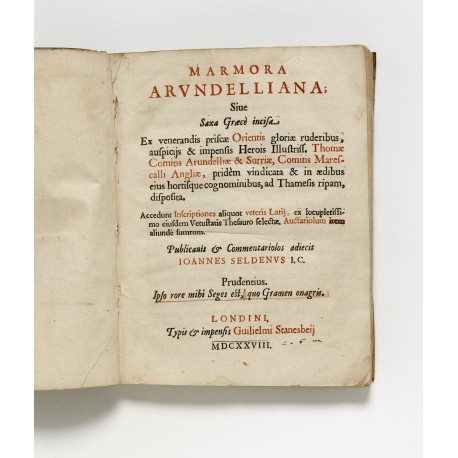 View larger
View larger
Marmora Arundelliana; siue Saxa Graecè incisa Ex venerandis priscae Orientis gloriae ruderibus, auspicijs & impensis Herois Illustriss. Thomae Comitis Arundelliae & Surriae, Comitis Marescalli Angliae, pridèm vindicata & in aedibus eius hortisque cognominibus, ad Thamesis ripam, disposita. Accedunt Inscriptiones aliquot veteris Latij, ex locupletissimo eiusdem Vetustatis Thesauro selectae. Auctariolum item aliundè sumtum
- Subjects
- Archaeology, Greek & Roman - Early works to 1800
- Epigraphs - Early works to 1800
- Authors/Creators
- Selden, John, 1584-1654
- Printers/Publishers
- Stansby, William, active 1597-1639
- Owners
- Blackmer, Henry Myron, 1923-1988
- Other names
- Arundel, Thomas Howard, Earl of, 1585-1646
- Young, Patrick, 1584-1652
Selden, John
Sussex 1584 – 1654 London
Marmora Arundelliana; siue Saxa Graecè incisa Ex venerandis priscae Orientis gloriae ruderibus, auspicijs & impensis Herois Illustriss. Thomae Comitis Arundelliae & Surriae, Comitis Marescalli Angliae, pridèm vindicata & in aedibus eius hortisque cognominibus, ad Thamesis ripam, disposita. Accedunt Inscriptiones aliquot veteris Latij, ex locupletissimo eiusdem Vetustatis Thesauro selectae. Auctariolum item aliundè sumtum.
London, William Stansby, 1628
quarto (215 × 000 mm), (101) ff. signed (A)2 §2 ¶2 ¶¶2 &2 (– &2, cancelled as usual) B–Z2 Aa–Zz2 Aaa2 and paginated (18) 1–182 (2). Title and many other pages printed in red and black (red chiefly used in the text to indicate conjectural emendations); woodcuts and woodcut diagrams printed with the text.
provenance Henry Myron Blackmer (1923–1988), exlibris1 — Sotheby’s, ‘The library of Henry Myron Blackmer ii’, London, 11 October 1989, lot 303
A fine copy.
binding contemporary English flexible vellum.
First edition of Selden’s description of twenty-nine Greek and ten Latin inscribed stones in the collection of Thomas Howard, second Earl of Arundel (1586–1646). These had been acquired by Arundel from an agent in Symrna in 1626–1627, in competition with the Provençal scholar Nicolas-Claude Fabri de Peiresc. Selden’s book, prepared with help from the royal librarian Patrick Young (Junius) and Richard James (Cotton’s librarian), spread the fame of the collection throughout learned Europe.2
The sculpture at Arundel House eventually extended to thirty-seven statues, 128 busts, and 250 inscriptions, as well as sarcophagi, altars, and fragments. Selden gives a general description of the entire collection; however the inscriptions and their historical implications occupy most of his attention. He also comments on a group of Romano-British inscriptions that had been given to the Earl by William Camden, and on a number of stones inscribed with Hebrew found in the repairing of Aldersgate and acquired by Arundel. Selden suggests that the latter were part of a synagogue or fragments of a Jewish grave, of the late twelfth or early thirteenth century.3 ‘In his discussion of these Jewish sepulchral stones, Selden offers something of a survey of Jewish life and law in medieval London, including data on the laws regarding Jewish goods, loans, mortgages, usury, and worship. Moreover, Selden writes plaintively of the exile of Jews from England, a tragedy that he believes too many English citizens have wholly forgotten’.4
Before the collection arrived at Oxford in 1667 (presented to the University by the collector Earl’s grandson Lord Henry Howard, at the instigation of John Evelyn), about 115 of the inscribed stones were mislaid. The survivors obtained only partial protection there, most being inserted in the exterior walls of the Sheldonian Theatre, where large portions were utterly lost before copies of them had been taken. These circumstances greatly enhance the documentary value of Selden’s work.5
The sheets of this first edition were twice reissued in 1629 with a cancel title-page having the imprint of John Bill. About thirty copies of our 1628 William Stansby issue are located by the online English Short Title Catalogue, including five copies in North American libraries (Folger, Harvard, Huntington, Kansas, Yale).
references Fabia Borroni Salvadori, ‘Il Cicognara’. Bibliografia dell’archeologia classica e dell’arte italiana (Florence 1957), ii/1, p.192 no. 328 (1628 issue); Short-title Catalogue of Books printed in England, Scotland, & Ireland and of English Books printed abroad (London 1976–1991), no. 823; cf. Leopoldo Cicognara, Catalogo ragionato dei libri d’arte e d’antichità posseduti dal conte Cicognara (Pisa 1821), no. 3146 (1629 issue)
1. Leonora Navari, Greece and the Levant: The Catalogue of the Henry Myron Blackmer Collection (London 1989), no. 1522.
2. Peiresc noted in a letter of 1629 that Marmora Arundelliana was already circulating in Rome, and that he had read it in Paris as soon as it came out; see Lettres de Peiresc, edited by Philippe Tamizey de Larroque (Paris 1888–1898), v, p.328. For Rubens’ praise of the collection and Selden’s work, see his letters to Pierre Dupuy and Peiresc (The Letters of Peter Paul Rubens, edited by Ruth Saunders Magurn, Cambridge, ma 1955, pp.320–323; Prosper Arents, De Bibliotheek van Pieter Pauwel Rubens: een reconstructie, Antwerp 2001, p.245 no. H74). Constantijn Huygens had seen Arundel’s collection and owned a copy (1629 issue) of Selden’s book (Catalogus… Bibliothecae… Constantini Hugenii, The Hague 1688, p.28 no. 41).
3. Graham Parry, The trophies of time: English antiquarians of the seventeenth century (Oxford 1995), pp.125–128.
4. Reid Barbour, John Selden: Measures of the Holy Commonwealth in Seventeenth-century England (Toronto 2003), p.108.
5. Selden is the sole witness (pp.1–21, 59–119) for the lost top half of the famous Parian Marble, which was broken up and part used for repairs at Arundel House during the Civil War; see the critical edition of Felix Jacoby, Das Marmor Parium (Berlin 1904), and generally, Adolf Michaelis, Ancient Marbles in Great Britain (London 1882), pp.17–18.



